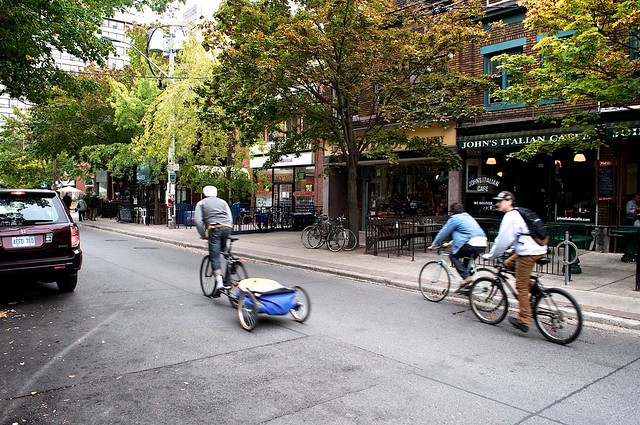
Walking onto Baldwin Street at lunch hour is like walking into a Business Improvement Area’s best-case scenario: the trees are lush, the storefronts funky, and the restaurant patios packed. Every time I walk down the street, I suddenly want to call someone to make lunch plans. The short strip’s buzz is undeniable. This is all the more impressive given that Baldwin is one of few commercial streets of its kind that isn’t organized into a BIA. Instead, Baldwin Village is fortunate enough to have established a strong, attractive identity from its storied history, which culminates in today’s community-minded tenants.
The street’s formal identity can be traced back to Dr. William Warren Baldwin, who moved to Upper Canada from Ireland in 1798. Five years later, Baldwin married his landlord’s daughter, Phoebe Willcocks. The two built their estate on property she’d inherited, at what is now Spadina House. In 1836, Baldwin laid out Spadina Avenue south to Queen, with many of its various offshoot streets named after Baldwin’s family members or, in the case of Baldwin Street, after his own family name. The recognition’s merited; although he’d trained as a doctor in Ireland, Baldwin spent his time in Canada as a lawyer, judge and eventual political figure in Upper Canada’s Parliament.
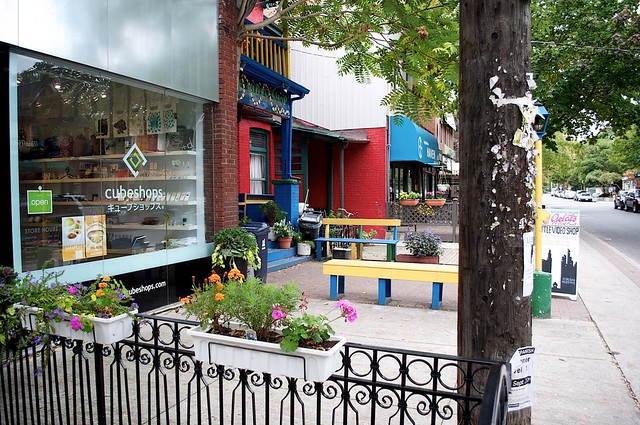
Over the years, Baldwin Street has gone through as many identities as the man it’s named after. During William Baldwin’s time it was home to mostly Irish immigrants and large plots of land. Toronto Life’s 2007 feature story on Baldwin traces many of the street’s current two-storey buildings back to Jewish origins in the early 1900s — a window at John’s Italian Caffe still features a former establishment’s small Hebrew script, for example. By the 1960s, much of Baldwin’s Jewish population had moved on, replaced by young hippies who turned Baldwin into one of Toronto’s key havens for draft-dodgers. John Phillips’ photography portfolio includes a series that gives a great look into the lifestyle on Baldwin at the time. This hippie population successfully protested the construction of a Toronto Hydro transformer station, and secured the area for its current generation of tenants. A number of first person stories about Baldwin Street are available on this [murmur] site.
While Yorkville has a similar past with tie-dye and peace signs, today’s incarnation of Baldwin hasn’t strayed as far from its bohemian roots as Yorkville has. Most of the street’s independent restaurants and businesses maintain bright, often hand-painted facades and friendly prices. Recent arrival Cubeshop’s Japanese novelties do offer a bit of high modern design, but they’re balanced out by the nostalgia of Around Again Records across the street.

In fact, one of Baldwin’s biggest strengths is its balance. Its laundromat, video store and health food grocery all serve the immediate neighbourhood, but its assortment of restaurants are also a draw for those from farther afield. Anyone coming just for a lunch or dinner still gets the strong sense of being in a neighbourhood, and those in sweatpants out to wash their jeans mix with those in suits on a lunch break from business. Kuni Sushi Ya even proudly displays a photograph of Samuel L. Jackson dining at their Baldwin restaurant.
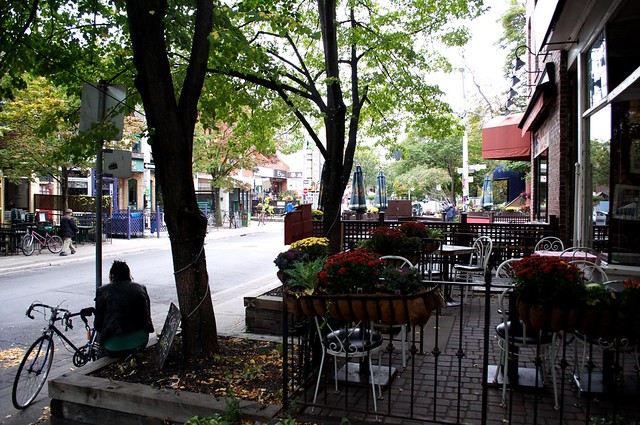
Mind you, Baldwin’s more notable for the collective culture created by the diversity of its offerings than for any one standout. Indian, Thai, Italian, vegetarian, Mexican, Chinese, Japanese, and Vietnamese are all built into the block, making for very eclectic side-by-side pairings in terms of both tastes and sights. In the Toronto Life feature, the founders of Baldwin’s restaurants talked about taking decor cues from the travels that led them to the street: John’s Italian Caffe founder John Lostracco borrowed from Greenwich Village, while Bodega’s Philip Wharton worked off of his recollection of Provence.
Of course, there have been some recent casualties on the street. Rejoice Coffee Shop spent the winter setting up shop, opened in May and was closed by the end of August. Word among neighbouring businesses is that it simply couldn’t make rent, suggesting that Baldwin’s shifted from being the kind of ground to nurture new start-ups. Nonetheless, Leila DeCiantis, owner of The Little Video Shop on Baldwin, noted that the vacancy is an opportunity to fill some cultural gaps, namely with a Greek or Middle Eastern restaurant.
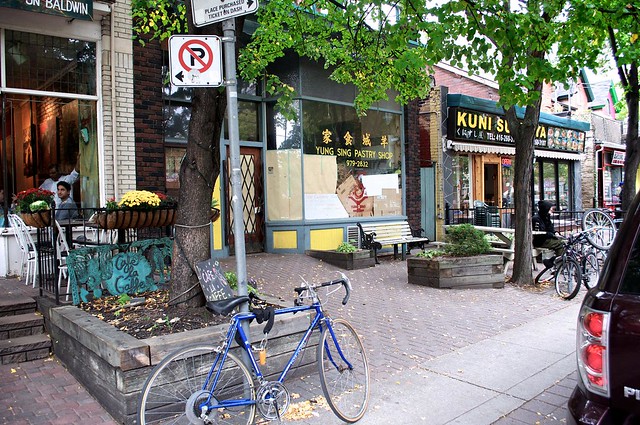
Meanwhile, Yung Sing Pastry Shop closed last fall, with a sign pledging a renovation and eventual return in “Spring/Summer ’10.” No construction’s taken place since, and devotees of its tofu buns have taken to mourning its death on Chowhound. BlogTO investigated, and wrote that the shop’s owners closed to battle health issues, but are attempting to pass the restaurant on to their children. Still, they renew hope that it might eventually reopen. No one I spoke to in the neighbourhood had heard much of anything else; they just added that they too miss Yung Sing’s tofu buns.
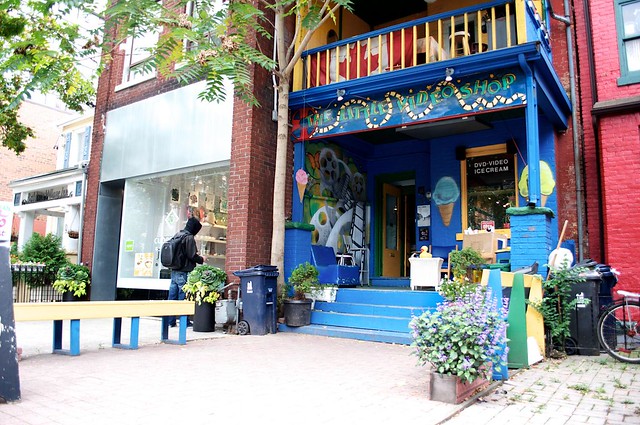
Despite these closures, Baldwin’s sidewalks were still packed with other patios every time I walked by this summer. The street’s pedestrian initiatives also seek to offer a new way to walk the street. Baldwin’s Pedestrian Sundays began four years ago as an initiative by a group of its long-term residents. Although three Sundays were held in the first year, organizers have since planned just one a year; the most recent was held September 19. Lila DeCiantis works to co-ordinate Baldwin’s pedestrian days, and is clearly someone who loves her pedestrians: at night, she projects movies on a screen in front of her video store and has benches placed out for passerby to watch from, like a sort of walk-up theatre. Talking about this year’s Pedestrian Day, she described how great it was to see across the street without cars blocking the view, and to see so many people out walking and dancing. In fact, many of The Little Video Shop’s clips of pedestrians dancing in the streets bear a striking resemblance to John Phillip’s photos of hippies in the 60’s. Not long into my chat with DeCiantis, she started excitedly talking about a day when Baldwin might be permanently pedestrianized, noting that it’s quite feasible since there are still access roads that could make deliveries to businesses’ backdoors. For now though, she acknowledges there’s significant red tape to co-ordinating just one pedestrian day — almost $1000 in fees to cover insurance, barricades, and permits, and mixed support from some of the street’s restaurants.
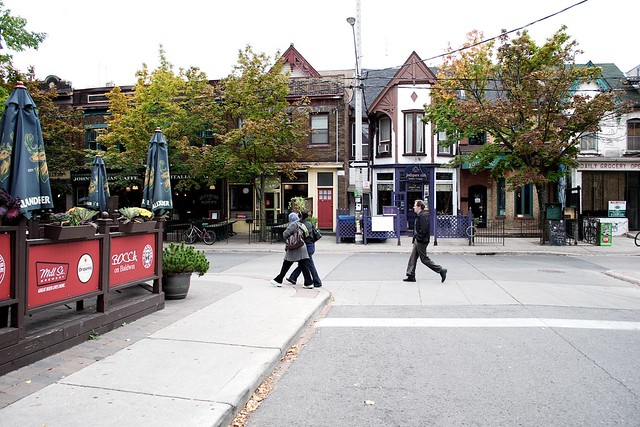
For her part, the City’s Manager of Pedestrian Projects Fiona Chapman says she has plans to develop better support for communities looking to host such pedestrian days. She hopes to produce a manual guiding the process, a grant for those residents organizing such events, a bank of borrowable furniture, and clearer guidelines for police involvement and fees. In the long term, her vision is to move away from event-focused pedestrian days to more routine closures, where people know of and expect pedestrian freedoms on weekends, for example. Indeed, DeCiantis says she hopes to better ally Baldwin’s future pedestrian Sundays with Kensington Market, to benefit from Kensington’s reputation for holding such regular pedestrian days.
Any time I’ve posted some sort of photo to Facebook or Twitter with Baldwin as the backdrop, I almost immediately get a comment or two asking about the location. More often than not, others beat me to answering — those who know Baldwin are eager to share their love for such an eclectic little part of Toronto. I’ve found my time in Toronto nicely paced out; you get to know its best streets and neighbourhoods slowly as you happen upon them. In the case of Baldwin Street, you discover something so busy with colours and people that it really gives you a renewed take on what a Toronto street can look like.
Street Stories is a regular feature profiling the origins, development and current state of Toronto streets. For more background on the history of Baldwin and other Toronto streets, we recommend the excellent book Toronto Street Names. If you have an idea for a street we should feature in an upcoming instalment, email ericmutrie@spacing.ca. More photos of Baldwin can be seen in our Flickr set.

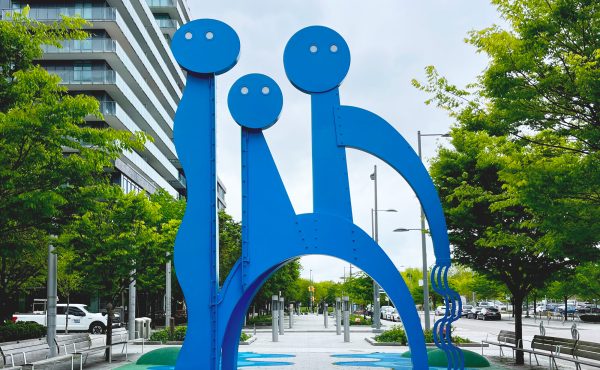
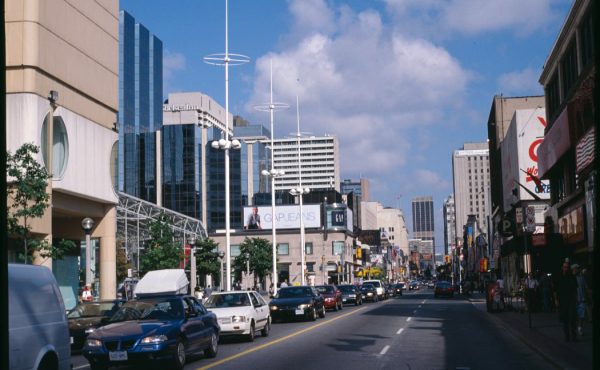

10 comments
Absolutely wonderful street. A monument to organic neighbourhood growth.
I still miss Yung Sing Pastry…
A very lovely, interesting, and well-researched article into beautiful Baldwin Street, one of Toronto’s treasures.
However, you missed one aspect of the Baldwin Street story that is worrisome,.and leads one to doubt the City of Toronto’s commitment to preserve these kind of magical urban places.
A few years ago, the City permitted the demolition of four or five of the funky little homes on the north side of Baldwin, immediately west of McCaul. Several delightful indie businesses, including the bonsai man, lost their premises, to be replaced by characterless residential townhouse. That part of Baldwin has died.
This is a a mini-version of what’s happened on West Queen West – as an area becomes more interesting and desirable, developers are there to exploit it, by knocking down the old and building the characterless new, thereby destroying that which made the place interesting and desirable in the first place.
Baldwin needs a bar or a pub. The street is dead every night by Midnight. Otherwise, it’s pretty darn close to perfect.
Moleski,
Your concerns are city wide. Developers do not want to build small commercial spaces. Look at the pathetic performance of the city’s ground floor retail spaces in new buildings. I am afraid that by 2015, areas such as this, which are so important to Toronto, are going to face insurmountable pressure to redevelop the commercial properties into residential.
Yes, a neighbourhood should be able to change and evolve, but we must be careful not to let it evolve into something dead with developments that aren’t respectful of heritage and the mixed-use principles that helped it become successful in the first place.
There are two pubs around the corner that fit in well — though not on Baldwin itself. One is Sin and Redemption, that I initially wrote off because the awful name — but it’s actually quite nice.
William Warren Baldwin was certainly Irish but his medical degre was from Edinburgh. His thesis is:
Baldwin, William Warren, 1775-1844.
Dissertatio medica inauguralis, de febre continua communi : quam, … pro gradu doctoris, … eruditorum examini subjicit Gulielmus Warren Baldwin, Hibernus; … Edinburgi : typis Georgii Mudie et Filii, 1797.
Shawn, you may have already noticed yourself, but I only just realized Sin and Redemption is right opposite St. Patrick’s Catholic Church, so the name makes a bit more sense.
Sin & Redemption used to be a religious store to service the church. Busts of Mary were proudly displayed in their window and plates with baby Jesus. It’s particularly funny (and probably no accident) that it is now called Sin & Redemption. It is the same owner as the VIP (Village Idiot Pub) right on the corner of Dundas/McCaul.
I’m not sure these still count as Baldwin Village though. It would be nice to see one bar/pub right on that street.
In my day job I deal with a lot of signage reviews for retail businesses. It would be very interesting to develop a set of signage guidelines based on a successful, organic street like Baldwin to help new streetscapes with signage that is lively but not in shambles, and clean without being monolithic. Great pics.